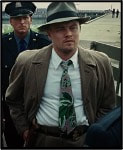LLCER Anglais | Site d'aide à la phonologie anglaise, grammaire, linguistique et civilisations anglophones
2| Fire & Water Throughout the film there is much symbolism to be found through the use of fire and water. Fire represents the fantasy Andrew/Teddy has created around himself. This is why his hallucinations are always accompanied by fire in one way or another. Water, on the other hand, represents the reality of what happened to his wife and children. This is why Andrew/Teddy has a consistent aversion to water throughout the film. Using cinematography in subtle ways, these symbols are present throughout the film to allude to the fact that Teddy is living in a dream world. In fact, from the very start, Scorsese (The Director) drops subtle hints that should make the viewer ask questions, yet just like the protagonist, we choose to ignore most of these clues until the very end. In the first scene we find a supposedly sea-sick Daniels vomiting into a ferry toilet. Yet when the camera cuts to a shot [plan] looking out of a porthole [hublot], not a single wave can be seen. This is the first demonstration of our protagonist’s aversion to water. Shortly after, upon arrival on Shutter Island, Chuck (Dr Sheehan) fumbles with his gun when asked by the guards to hand it over, and after a few moments gives them both the gun and holster. This detail should immediately tell us that Chuck is not a real Marshall and has little experience with guns, but it goes by mostly unnoticed. Later, when Teddy & Chuck reach the cliffs, they find most of the guards sitting down or skipping stones [faire des ricochets], rather than searching for Rachel Solando. This is because they are aware that Rachel does not exist, but is rather a figment of Laeddis’ imagination, and therefore they have no real motivation to search for her. In one of the most interesting and telling scenes of the film; Teddy and Chuck interview patients about the disappearance of Rachel Solando. In the scene each character is framed in their own shot. There is a guard present in both the background [arrière-plan] of the old woman’s shot and Teddy’s shot. Yet when the camera cuts to Chuck, there is no guard behind him. This was an intentional creative decision made by the cinematographer/director to hint at Teddy being a patient at the asylum. Just like the old woman, Teddy needs to be guarded, however because Chuck is actually a doctor at the asylum there is no need to guard him. Another tell-tale sign [signe caractéristique] that all is not what it seems is when Chuck hands the old woman a glass of water. When she lifts the glass to her lips nothing is in her hand. This shot is purposefully framed from Teddy’s point of view. We already know that Teddy has an aversion to water as it reminds him of the drowning of his children in the lake, at the hands of his late, manic-depressive [maniaco-dépressif/ive] wife. It is this aversion that causes Teddy to mentally ignore the glass of water in the old woman’s hands until it later reappears in the next shot (outside of Teddy’s perspective) as an empty glass once she had drunk its contents. This is another example of how in the film water represents Teddy’s reality, and how he rejects that reality. When Teddy asks the old woman about Dr Sheehan, she glances over to “Chuck”, who is sitting next to Teddy, as she knows he is in fact Dr Sheehan. When Teddy then asks whether she knows Andrew Laeddis, she is even more flustered as she knows that Teddy is in fact Laeddis but has been told not to tell him the truth. Finally, the old woman writes ‘run’ on Teddy’s notebook, not because Ashecliffe is running experiments on its patients, but because she knows that this is Teddy’s last opportunity to escape the mental hospital. This scene is one of the most important in the film as it employs careful acting, cinematography, and symbolism to greatly hint to the audience that Teddy is a mental patient long before the big reveal. When Teddy dreams about Laeddis, Laeddis sits beside the fire in an armchair. Teddy’s version of Laeddis; a scarred and disfigured man, then lights a match and proceeds to light Teddy’s cigarette. This act of Teddy accepting the light from Laeddis is symbolic of Teddy accepting this fantasy as reality. Later, when Teddy finds Rachel Solando in a cave, the only light source is her campfire. The fire is ever-present in each shot and always in frame during their interaction, another hint to the audience that what we see before us is Teddy’s delusion and not reality. When talking to George Noyce in ward C, Teddy uses a single match to illuminate the scene. Once Noyce begins to reveal the truth to Teddy about the experiment, the match leaves the frame of the shot. However, Teddy rejects Noyce’s warnings and strikes another match. Once he does, he begins to hallucinate once again. He sees his late wife in Noyce’s cell. 3 | Conclusion This film tells the audience the truth the entire time, and not just through symbolism, but also through cinematography, acting and directing. Each scene is constructed in a way to show us what is really happening, yet we still do not understand the truth. We; the audience, have the ability to deny reality even if it is staring us in the face. We always want to hold to what we believe to be true, even in the face of extreme evidence to the contrary. AuteurJames Holland et Teddy Barbier | Professeurs d'anglais Catégories |

8/25/2021
0 Commentaires